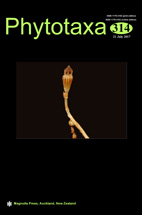Abstract
Here we describe a new species of the mycoheterotrophic genus Thismia (Thismiaceae), T. brunneomitroides, discovered during a botanical survey in Khao Luang National Park, Peninsular Thailand. Thismia brunneomitroides resembles Thismia brunneomitra from Brunei Darussalam in that both species possess inner tepal lobes that are connate to form a mitre with three projections at the apex and large lateral appendage of the connective. However, it differs in having ivory flowers with twelve pale orange to brownish orange vertical stripes on the perianth tube and slightly dentate lateral appendage of the connective which does not exceed apical part of the connective. Descriptions, illustrations and a key to the 13 species of Thismia in the Thai-Malay Peninsula are provided.

